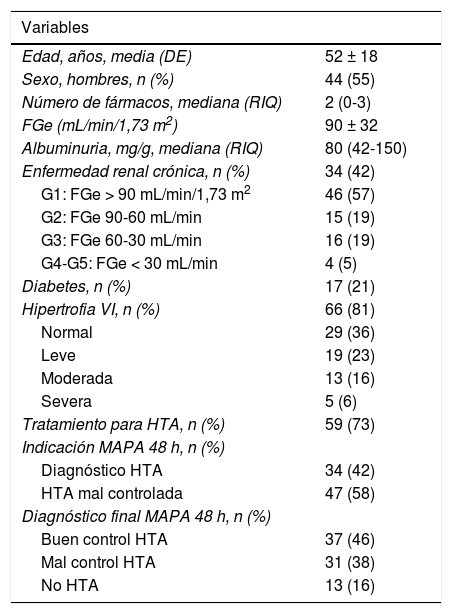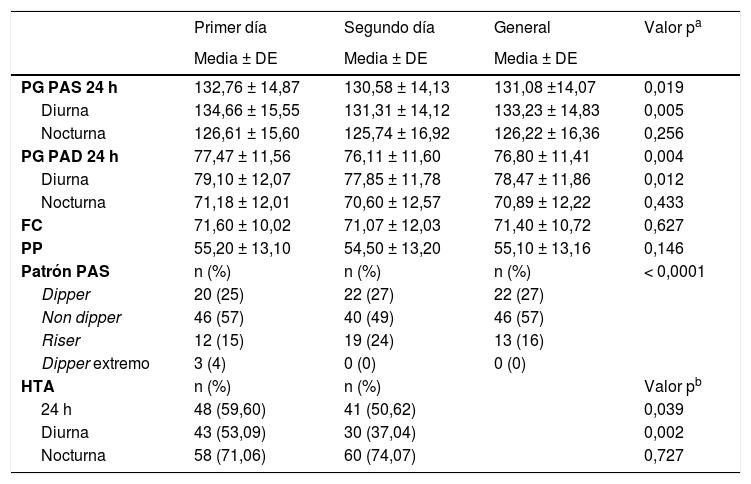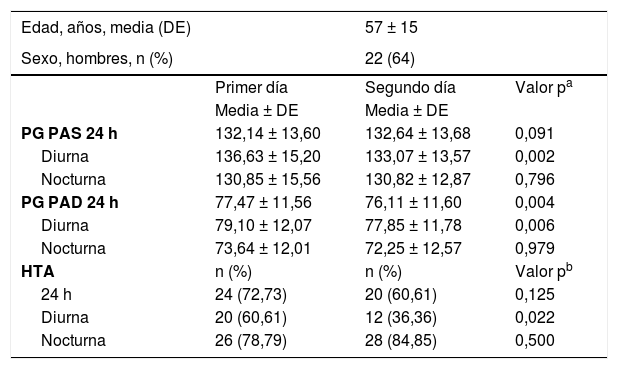La monitorización ambulatoria de la presión arterial (MAPA) es una herramienta básica en el diagnóstico y tratamiento de la hipertensión arterial (HTA). La validez se basa en el número de mediciones realizadas y en su duración. Nuestro objetivo es estudiar en nuestra serie de MAPA de 48 h, si existe justificación para ampliar la duración de la MAPA a 48 h.
Material y métodosAnálisis retrospectivo de una serie de casos formada por 81 pacientes con MAPA de 48 h durante un periodo de cinco años (2013 a 2018). Se analizan las diferencias entre el primer y segundo día.
ResultadosOchenta y un pacientes, 44 hombres, edad media 52 años (± 18). Mayor promedio de presión arterial (PA) en el primer día (132/77 mmHg vs. 130/76 mmHg, p ≤ 0,01) y también mayor proporción de pacientes con HTA el primer día (59 vs. 50%; p ≤ 0,05). Los pacientes con enfermedad renal crónica (ERC) (n = 33) presentaron PA sistólica (PAS) mayor en la segunda noche (p ≤ 0,05), un patrón circadiano de mayor riesgo en el segundo día (dipper 13,6 vs. 86,4%, nondipper 60,7 vs. 41,7% y riser 30,3 vs. 18,8%; p ≤ 0,05), más diabetes (39%, p ≤ 0,01) y más hipertrofia del ventrículo izquierdo (HVI) (74%, p ≤ 0,05).
ConclusionesLa MAPA de 48 h podría determinar mejor los valores de PA y patrón circadiano que la de 24 h, en especial a los pacientes con ERC y diabetes, ambas patologías de elevado riesgo cardiovascular.
Ambulatory blood pressure monitoring (ABPM) is a basic tool in the diagnosis and treatment of hypertension (HT). Validity is based on the number of readings taken and their duration. Our aim was to study in our 48-hour ABPM series whether extending the duration of ABPM to 48 hours is justified.
Material and methodsRetrospective analysis of a case series comprising 81 patients with 48-hour ABPM over a 5-year period (2013 to 2018). We analysed the differences between the first and second day.
ResultsEighty-one patients, 44 men, mean age of 52 years (± 18). The mean blood pressure (BP) was higher on the first day (132/77 mmHg vs. 130/76 mmHg, p ≤ .01) and there was also a greater proportion of patients with HT on the first day (59 vs. 50%; p ≤ .05). The patients with chronic kidney disease (CKD) (n = 33) had higher systolic BP (SBP) on the second night (p ≤ .05), a circadian rhythm of higher risk on the second day (dipper 13.6 vs. 86.4%, non-dipper 60.7 vs. 41.7%, and riser 30.3 vs. 18.8%; p ≤ .05), more diabetes (39%, p ≤ .01) and more left ventricular hypertrophy (LVH) (74%, p ≤ .05).
Conclusions48-hour ABPM could determine BP readings and circadian rhythm better than 24-hour ABPM, especially in patients with CKD and diabetes, both diseases carrying high cardiovascular risk.
Artículo
Comprando el artículo el PDF del mismo podrá ser descargado
Precio 19,34 €
Comprar ahora








